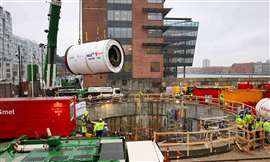Ten of the world’s biggest flood protection projects under construction
24 June 2024
From super sewers to flood barriers, governments around the world are investing in mega projects aimed at protecting cities from heavy storms. Lucy Barnard looks at some of the most ambitious resilience projects under construction around the world and the contractors building them.
The year 2024 may not be even halfway through but already it is shaping up to be one of the wettest on record.
In April, Dubai saw an entire year’s worth of rain fall in a single day, turning the international airport into a lake and flooding the subway. And in May, Brazil was hit by one of its worst-ever floods which killed 155 people and forced 540,000 from their homes.
For governments around the world, an increasing likelihood of catastrophic storms, combined with increasing rates of urbanization and the need to replace aging infrastructure, is prompting record investments into super sewers, flood barriers and resilience projects.
Construction Briefing had a look at 10 of the most significant.
New York, USA, flood barriers
In response to severe flooding as a result of Hurricane Sandy in 2012, New York’s city authorities have been considering ways to protect the city.
 Bjarke Ingels Group’s Big U concept design. Image: Rebuild by Design
Bjarke Ingels Group’s Big U concept design. Image: Rebuild by Design
The following year, the US Department of Housing and Urban Development launched Rebuild by Design, a US$930m design competition to make the city neighbourhoods damaged by the hurricane more resilient. Ten of the 150 proposals were selected and seven received federal grants.
The largest grant, totalling $335m went to ‘The Big U’ proposal, an ambitious plan by Danish architect Bjarke Ingels Group and others, which comprises a 12-kilometer-long barrier - or berm - around Lower Manhattan incorporating public spaces and parks designed to hold the flood waters back from the shores of Manhattan.
One of the largest segments of the Big U was known as the East Side Coastal Resiliency project. Under the original Big U plan, this included an 8-foot berm along FDR Drive from East 23rd Street to Montgomery Street. However, in 2018, following a city “value engineering” review, Mayor Bill de Blasio, announced that instead of building a berm, the whole 57.5-acre East River Park would be raised. In December 2019, the New York City Council voted to approve a $1.45bn plan to bury the park under eight feet of new soil and build a re-designed park on higher ground so that the new park can act as a flood barrier. Construction work started in 2021 after a protracted legal battle with local residents. IPC Resiliency Partners, a consortium of CAC Industries, Posillico Inc and Lovino is currently working on phase one of the project which is due to complete later in 2024. Perfetto Contracting is working on a second phase. The entire project is scheduled to complete in 2026.
Other segments of the Big U are also under way. Last year Battery Park City Authority, the body which administers Battery Park, awarded a US$631m design and construction contract for part of a “sea level resiliency project” to Turner Construction and its subsidiary EE Cruz to build a series of flood barriers around the southern tip of Manhattan. Separately, in June, the US Army Corps of Engineers awarded a $132.7 million contract to New York-based Triumph Construction to build a series of drainage ponds and stormwater infrastructure on Staten Island.
And further measures could be afoot. In 2022, after completing a feasibility study, the US Army Corps of Engineers released a tentatively selected plan comprising 2.2 miles of storm surge barriers, 50.6 miles of sea walls and other shoreline-based measures, 11.8 miles of induced flooding mitigation features and 18.7 miles of risk reduction features. The USACE estimated that the project would have a total present value cost of US$76.2 billion and would have an estimated construction duration of 14 years. If the plans get approved by New York and New Jersey officials and are signed off by Congress – and the funding is approved – construction could start as soon as 2030.
Dubai Strategic Sewage Tunnels Project, Dubai, UAE
In February 2024 the Dubai government invited contractors to bid to take on a AED80bn (US$22bn) sewage tunnel project which will be developed as a public private partnership. The project includes the construction of two sets of deep tunnels terminating at two pump stations located at sewage treatment plants in Warsan and Jebel Ali. A conventional sewage and drainage system and sewage treatment plants will be built in Hatta. It also includes recycled water distribution systems connected to the sewage treatment plants. The project follows the AED12.5bn (U$3.4bn) 75 kilometre-long, Deep Tunnel Drainage project which is up to 90 metres deep and was completed in 2021 by US-based Parsons and is part of a system designed to collect and store stormwater for the next 100 years.
MOSE, Venice, Italy
 The MOSE system in Venice, Italy. Photo: Adobe Stock
The MOSE system in Venice, Italy. Photo: Adobe Stock
Venice’s MOSE mobile flood barrier is actually a series of four barriers consisting of rows of mobile gates installed on the sea floor at the Lido, Malamocco and Chioggia inlets that can be raised to temporarily seal off the Venice Lagoon from the ocean during storms. The project was first subcontracted by the Italian government in 1984 to Consorzio Venezia Nuova, a consortium of major Italian companies. However, construction on the megaproject did not begin until 2003 and has been dogged by delays, cost overruns and allegations of corruption. The barriers were successfully raised for the first time in 2020 and were widely expected to be completed in 2021 but recent documents, published in Italian newspaper Il Fatto Quotidiano, now say interventions made possible by new funding take the completion date to December 2025. The project’s total cost has been estimated at €6 billion (US$6.5bn).
West Shore Lake Pontchartrain, Louisiana, USA
The West Shore Lake Ponchartrain project, located in southeast Louisiana on the east bank of the Mississippi River, comprises 17.5 miles of levees, a mile of concrete flood wall, pumping stations, drainage structures and other non-structural protection measures which are being coordinated by the US Army Corps of Engineers, New Orleans District, stretching from Bonnet Carre Spillway to the Mississippi River Levee near Garyville. The project, which has an estimated cost of US$760 million, is designed to provide storm surge protection to 60,000 residents in St Charles, St James and St John the Baptist parishes. Contracts for various construction packages on the project have been awarded to Louisiana-based companies including: Onshore Material; Mandeville Construction, Dynamic Group, EvCo Development and Lemoine-Frazier. Construction began in December 2022 and is expected to be completed in 2027.
Potomac River Tunnel, Washington DC, USA
A joint venture between CBNA, a US based subsidiary of French contractor Bouygues Construction and US-based Halamar International, supported by engineers COWI and Hatch, started work in February on the construction of a US$819m sewer and storm water drain designed to reduce the number of sewage overflows into the Potomac River in Washington DC. The 5.5-mile-long (8.9km) main tunnel will run beneath the Potomac River in Washington DC and connect to the existing Anacostia River Tunnel, storing storm water and effluent and conveying them to DC Water’s Advanced Wastewater Treatment Plant at Blue Plains. The 100 feet (30m) deep tunnel will have an internal diameter of 18 feet (5.5 meters) and will cross variable geographical conditions (clay, alluvium, hard rock) passing close to Washington DC’s iconic monuments. It will require the use of two tunnel boring machines customized specifically for these soil conditions. Works on the project are expected to complete by 2030.
The Thames Tideway Tunnel, London, UK
 The Thames Tideway Tunnel completed construction in March. Photo: Tideway
The Thames Tideway Tunnel completed construction in March. Photo: Tideway
Completed in March after eight years of construction, the £5bn (US$6.4bn) Thames Tideway Tunnel is the biggest infrastructure project ever undertaken by the British water industry. The 16-mile-long (26 kilometers), 7.2m-wide tunnel which runs from Acton in west London to Abbey Mills in east London will divert 34 of the most polluting sewage outflows which have been discharging into the Thames and store them into the tunnel until they can be processed. The first sewage is expected to flow into the new tunnel this summer and it should be fully operational in 2025. Contractors on the project included: BAM Nuttall, Morgan Sindall, Balfour Beatty, Ferrovial Agroman, Laing O’Rourke, Costain, Vinci and Bachy Soletanche.
Clearwater Project, Los Angeles
After a multi-year evaluation of the main sewer system of the Sanitation Districts of Los Angeles which serves more than 5m people, the Sanitation Districts agreed to build a 7-mile-long, 18-foot diameter tunnel to convey treated water from the Joint Water Pollution Control Plant in Carsen to existing ocean outfalls at Royal Palms Beach in San Pedro. In 2019 the districts awarded a US$630 million construction contract to Dragados USA, the US arm of Spanish contractor Dragados. The project is scheduled to complete in 2026.
Mill Creek Drainage Relief Tunnel, Dallas, USA
The Mill Creek Drainage Relief Tunnel, which is due to be completed in 2026, is a five-mile underground tunnel stretching from State Thomas district in uptown Dallas, through Mill Creek and Peaks Branch. The 30-foot diameter tunnel which sits 70 to 100 feet below ground is designed to protect nearly 6,000 residential and commercial properties in the east Dallas area from floods for the next century. The project is being built by Southland Mole, a joint venture of two Texas-based Southland Holding subsidiaries which was awarded the US$206.7 million construction contract in 2018. A Main Beam Robbins tunnel boring machine was used to drill through Austin chalk between spring 2020 and summer 2022 and a concrete lining is being added until 2025.
Cloudburst Tunnels, Copenhagen, Denmark
 The final stretch of the Kalvebod Brygge Cloudburst Tunnel. Photo: NIRAS
The final stretch of the Kalvebod Brygge Cloudburst Tunnel. Photo: NIRAS
Following a huge cloudburst in Copenhagen in 2011, the Copenhagen municipality identified the need for a new sewer and storm drain network which can direct cloudburst runoff from the city into the Øresund Strait. As a result the municipality came up with a Cloudburst Management Plan to build two new tunnels to drain storm water which it describes as “highways for water.” The Kalvebod Brygge tunnel extends over 1,360 meters while the Valby tunnel stretches 1,500 meters. The tunnels measure up to 3 meters in diameter and are located between 12 and 20 meters below sea level. Danish engineering company NIRAS started work on the project as a consultant in 2017. Tunnelling for the Kalvebod Brygge tunnel, using a TBM, completed at the end of 2023. Pumping stations are expected to be put into operation in 2026. At the end of May this year, a joint venture between Danish contractor MT Højgaard Danmark and French company Eiffage won the contract to build the 2,380m-long Valby cloudburst tunnel under a contract worth DKK 490 (US$71.3 million).
Ring Road no. 7 Underground Multibasin Regulating Reservoir, Tokyo, Japan
Tokyo already boasts the world’s largest underground water infrastructure, comprising 28 underground regulating reservoirs on twelve rivers with a total storage volume of 2.63 million cubic meters. However, after dramatic increases in the intensity and frequency of storms, the Tokyo Metropolitan Government’s Board of Construction earmarked an extra ¥6.6trn (US$42m) will go towards boosting the metro area’s flood defences. In 2022, it started work on a 5.4km long, 13.2-meter diameter tunnel-shaped reservoir, with a capacity of 1.4 million cubic meters connecting the existing underground reservoirs at Kanda River and Shirako River. Construction is expected to be completed in 2026.





